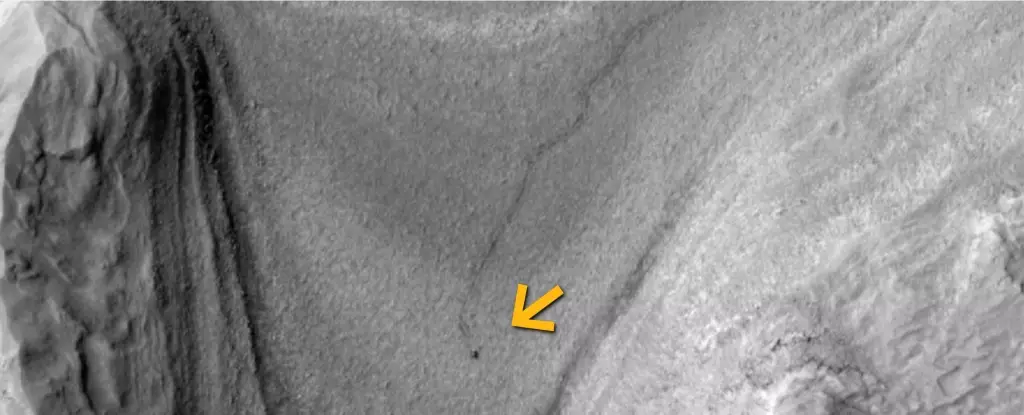Since its launch in 2011, NASA’s Curiosity rover has embarked on an unparalleled journey across the Martian landscape. This robotic explorer, stationed within the Gale Crater since August 2012, has become a symbol of our unending quest for knowledge about the universe. Its primary mission? To uncover the geological and hydrological history of Mars. Yet, as recent images from the Mars Reconnaissance Orbiter illustrate, Curiosity’s impact transcends mere scientific inquiry; it captivates the imagination and embodies the essence of exploration.
Every time Curiosity ventures across the rugged terrains of the red planet, it etches a narrative that resonates with both scientists and enthusiasts alike. A remarkable image captured on February 28 reveals the rover in all its solitary glory—a minute black speck against the vast Martian landscape, accompanied by the winding gray trail of its wheels. This snapshot serves as a poignant reminder of Curiosity’s relentless endeavor and positions it as an iconic figure in the annals of space exploration.
Challenges of the Martian Environment
Curiosity’s journey is not without its challenges. The rover navigates an unpredictable environment characterized by fierce Martian winds and a rugged terrain that demands caution. Its operational speed, peaking at a modest 160 meters per hour, is a deliberate choice dictated by multiple factors. Given its significant weight and the limitations of its 110-watt nuclear generator, a slow pace conserves energy and enhances its ability to traverse complex landscapes without straining its delicate systems.
Moreover, this plodding pace allows Curiosity to gather meticulous data while scrutinizing its surroundings. As it traverses a path of approximately 34.59 kilometers, each journey unfolds a story that contributes to our understanding of Mars, depicting a world that may reveal secrets of its past, including the possibility of ancient microbial life.
Uncovering Mars’ Rich History
The rover’s exploration of the Gediz Vallis channel stands out as a significant highlight of its mission. Once thought to be shaped by torrents of water, this channel has become an archaeological site for geologists who seek to understand the dynamics of an ancient Martian climate. During this exploration, Curiosity discovered a unique deposit of elemental sulfur, an exciting find that hints at Mars’ complex geological history. Scientists are currently analyzing these sulfurs, nurturing theories about their formation and significance—a process that embodies the spirit of scientific inquiry.
As Curiosity has left the Gediz Vallis channel, it has ventured into diverse geological formations, such as the intriguing Devil’s Gate. Here, the rover employs its chemistry lab to analyze rock samples, extracting valuable information about the planet’s composition. One particularly captivating formation it has encountered is the Hale Telescope, with its intriguing layered structure reminiscent of a geologic cake. The composition and formation of these layers may unlock insights into ancient environmental conditions, providing indirect evidence of the potential for life.
Future Prospects and the Quest for Life
Curiosity’s continued mission is both thrilling and vital, particularly as it approaches formations known as boxwork—complex mineral arrangements indicative of past hydrothermal activity. Such formations beckon to scientists not merely for their aesthetic value but for the tantalizing possibility they hold for discovering signs of ancient life. These minerals, originally deposited when conditions on Mars were vastly different, suggest the existence of warmer and wetter environments conducive to sustaining life. For trace evidence of microbial existence, these geological wonders could be the ideal target for exploration.
Curiosity operates as more than just a scientific instrument; it’s a testament to human determination and innovation. While it may ultimately leave only ephemeral imprints on the Martian soil, its findings resonate far beyond the red planet. They invite us to ponder our place in the cosmos and inspire future generations of explorers. As it roams the Martian expanse, Curiosity continues to serve as both a sentinel of learning and a beacon of hope as we look to the stars—a reminder that even from light-years away, the spirit of inquiry and exploration endures.


Leave a Reply